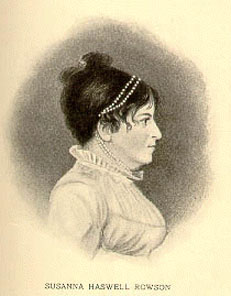Here is an example of a successful response to the Close Reading Assignment by Amanda Festa.
Eliza’s
mind was quick, active, and sagacious; but her total inexperience gave her
sometimes the appearance of folly. She
was eager to fly from this house, and to resign herself and her property,
without limitation or condition, to my controul. Our intercourse had been short, but she
relied on my protection and counsel as absolutely as she had been accustomed to
do upon her father’s. She knew not what
answer to make to my enquiry. Whatever I
pleased to do was the best. What did I
think I ought to be done?
Ah!
Thought I, sweet, artless, and simple girl! how wouldst thou have fared, if
Heaven had not sent me to thy succour? (Brown 215)
This
passage is from the point of view of Arthur Mervyn, who is relating his recent
whereabouts to Dr. Stevens. He had
returned to the Hadwins’ home to find the family drastically affected by yellow
fever. Eliza Hadwin, the youngest
daughter, is the only surviving family member and Mervyn believes it his responsibility
to protect her. He rationalizes this
thought by referring to “her total inexperience,” yet also notes the prowess of
her mind which was “quick, active, and sagacious.” Throughout the text the role of women has
been important to note. From the very
beginning, where Dr. Stevens consults his wife before taking in a sick Mervyn,
it becomes clear that women are given a voice in the novel, which albeit
limited, was advanced for the time. The complex function of women in the novel
can be seen clearly in the first sentence of the above passage. She is thought “sagacious” or wise, a term
which calls up the image of a “sage” or someone who is looked to for wisdom,
yet this stands in contrast to her “inexperience,” which is in direct
opposition to wisdom. This first
sentence sets up the tone of the passage, as well as the gender roles set forth
in the novel. Women are, at least for
the time period, given voice and respect within the novel, yet as progressive
as the male/female relationships may be, they are still controlled by male
figures, who stand as either protectors or seducers.
Eliza
is ready and willing to “fly” from her childhood home and “resign” herself and
“her property” to Mervyn’s “controul.”
The contrast between the words “fly” and “resign” are similarly relevant
in their opposition. Eliza’s ability to
“fly” or be free is hindered by her gender.
She has not the ability to escape her position without giving “controul”
to a male figure, in this case Mervyn.
The Oxford Dictionary defines “resign” as the “surrender [of] oneself
to another’s guidance” and “to be resigned” as “accept[ing] that something
undesirable cannot be avoided” (http://oxforddictionaries.com/). Eliza cannot “fly” and thus must “surrender”
herself to the most tolerable of her options.
“Herself and her property” is grouped together here, and ultimately are
one and the same. She becomes part and parcel
of her “property” given to Mervyn’s “controul.”
Although
Eliza does not speak in this passage, Mervyn speaks for her, usurping her voice
and making assumptions of her wants and needs.
He states that “she relied on my protection and counsel as absolutely as
she had been accustomed to do upon her father’s.” The word “absolutely” here reinforces the
power Mervyn possesses. There is no
restriction on Mervyn’s control of Eliza’s person at this moment. What power her father once possessed now
belongs to Mervyn, an exchange from one male to another. Although attributed with a “quick,” “active”
and “sagacious” mind,” it is still relayed that “she knew not what answer to
make.” It is up to Mervyn, (according to
Mervyn) to do “whatever I pleased to do was the best.” The placement of this statement after Eliza’s
inability to answer Mervyn gives the reader the initial feeling that it is
Eliza who conceded to Mervyn to do “whatever [he] pleased.” Yet, between the lack of dialogue in this
passage and the given perspective, which is Mervyn’s, one cannot be sure if
Eliza has granted Mervyn permission to do what he wants, or if Mervyn is simply
taking it upon himself.
At
the start of the next paragraph, Mervyn now refers to Eliza as “sweet, artless,
and simple,” these terms standing in direct contrast to the terms previously
used to describe her at the start of the preceding paragraph (“quick, active
and sagacious”). Mervyn then invokes a
religious tone, asking “how wouldst thou have fared, if Heaven had not sent me
to thy succour?” At this point, his tone borders on pretentious. He is no
longer simply her protector, but her overarching savior. While it is true that there are deceitful
characters in the book such as Welbeck who act as foils to Mervyn, the latter
does have instances where his hubris begins to overwhelm.
Ultimately,
this passage speaks to the novel’s larger thematic concerns with gender and the
relationship between the sexes. Women
are given a variety of roles in the novel, from respected confidant (Mrs.
Stevens) to Eliza, who although thought “wise” needs the protection and
guidance of a man to maintain her virtue.
This passage relays Mervyn’s positive attributes, in his kind hearted
decency, yet also exposes his hubris, which is an unfortunate side effect of
his active benevolence.







